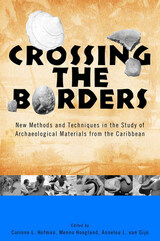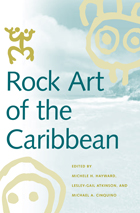2 books by Kelly, Harold J

Crossing the Borders
New Methods and Techniques in the Study of Archaeological Materials from the Caribbean
Edited by Corinne L. Hofman, Menno Hoogland, and Annelou L. van Gijn
University of Alabama Press, 2008
Explores the application of a selected number of newly emerging methods and techniques
During the past few decades, Caribbean scholars on both sides of the Atlantic have increasingly developed and employed new methods and techniques for the study of archaeological materials. The aim of earlier research in the Caribbean was mainly to define typologies on the basis of pottery and lithic assemblages leading to the establishment of chronological charts for the region, and it was not until the 1980s that the use of technological and functional analyses of artifacts became widespread. The 1990s saw a veritable boom in this field, introducing innovative methods and techniques for analyzing artifacts and human skeletal remains. Innovative approaches included microscopic use-wear analysis, starch residue and phytolith analysis, stable isotope analysis, experimental research, ethnoarchaeological studies, geochemical analyses, and DNA studies.
The purpose of this volume is to describe new methods and techniques in the study of archaeological materials from the Caribbean and to assess possible avenues of mutual benefit and integration. Exploring the advantages and disadvantages in the application of a selected number of newly emerging methods and techniques, each of these approaches is illustrated by a case study. These studies benefited from a diverse array of experience and the international background of the researchers from Canada, the Netherlands, Cuba, Puerto Rico, Martinique, Italy, Mexico, Dominican Republic, England, and the United States who are integral members of the archaeological community of the Caribbean. A background to the study of archaeological materials in the Caribbean since the 1930s is provided in order to contextualize the latest developments in this field.
[more]

Rock Art of the Caribbean
Edited by Michele Hayward, Lesley-Gail Atkinson, and Michael A. Cinquino
University of Alabama Press, 2009
This compilation, by an international grouping of scholars, focuses on the nature of Caribbean rock art or rock graphics and makes clear the region's substantial and distinctive rock art tradition. Thorough and comparative, it includes data on the history of rock graphic research, the nature of the assemblages (image numbers, types, locations), and the legal, conservation, and research status of the image sites. Chapters on these topics cover research on the islands of Cuba, Haiti, Dominican Republic, the Bahamas, Jamaica, Puerto Rico, U.S. Virgin Islands, Guadeloupe, Aruba, and Bonaire. The prehispanic rock art and other ceremonial structures and artifacts, along with enthnohistorical accounts of the region at Contact, projected backward in time, all point to an active ritual and ceremonial life involving commoners, religious specialists, and elites in differing and interconnected roles and for diverse purposes. The selective use of common rock graphic design and physical elements can be seen in the distribution and execution of the carved and painted images. Pecked, ground, abraded, and scratched petroglyphs, along with pictographs done frequently in red, black, white and orange hues are found on a range of rock surfaces including limestones, granites, diorites, and andesites. Caves/rock shelters and rock formations associated with water sources (water ways, pools, ocean) account for the two most common locations, followed by ball court sites, inland rock outcroppings and beach rock.
In addition to specific area presentations, the work includes a review of recent advances in Caribbean rock graphic studies including dating and interpretative models; the application of a new documentation method and resulting computer manipulation advantages; a conservation project in Jamaica that has implications for the preservation and interpretation of the site; and a proposed dating sequence for the Lesser Antillean
Windward Islands.
[more]
READERS
Browse our collection.
PUBLISHERS
See BiblioVault's publisher services.
STUDENT SERVICES
Files for college accessibility offices.
UChicago Accessibility Resources
home | accessibility | search | about | contact us
BiblioVault ® 2001 - 2024
The University of Chicago Press









